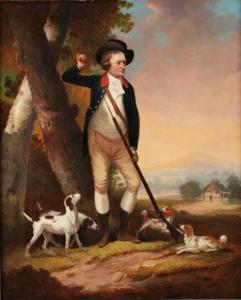The artist I have chosen to do my presentation on is William Williams, an English-born American Colonial Era Painter, 1727-1791. He also wrote a novel, The Journal of Penrose, Seaman, considered by many to be the first American novel. William Williams, specializes in small full-length portraits. A fun fact is that he had one son, who also became a painter.
The first artwork I have chosen is the painting called "Deborah Hall" (1766). The painting is oil on canvas. The materials William Williams used was a paint brush, a very large canvas which is 71 3/8 x 46 3/8 big and he used alot of soft colors except on her dress. The color of her dress which in my opinion is like a salmon color makes her stand out beautifully in the painting. It makes her the focal point. This piece is representational. This is a painting of his sitter. Deborah Hall, was the daughter of the Philadelphia printer David Hall, who had once been in partnership with Benjamin Franklin. As you can see from the richness of Deborah's dress, the huge garden setting, and the size of the picture (71 3/8 x 46 3/8) in all serve as signs of the family's wealth and status. In this painting William Williams adds a few touches that tells us a little bit about "Deborah Hall", for example, the rose that she plucks was a familiar symbol of love and beauty, the domesticated squirrel of obedience, and the mythological story of Apollo and Daphne, pictured on the pedestal, of chastity. I connect with this painting because I love how real this painting looks.
The second piece I have chosen from William Williams is called "Portrait of Henry" 1st Lord Mount Sandford reloading his fowling piece, with dogs in attendance . This painting is also oil on canvas. In my subjective opinion, Henry looks like he is in the military. He is loading or reloading his weapon and he has 4 dogs around him. He may possibly be hunting. Once again, this painting is representational. I like the he didn't put Henry in the middle of the painting but instead he put him slightly to the left and used the right side of the canvas for a house in the distance which in my opinion gives it kind of a story. William uses soft tones in this one too but in the coat that Henry is wearing he used a dark blue with red collars to bring out that Henry is in the military. I connect with this painting because I was in the military to and I have been hunting a few times.
The third piece is have chosen from William Williams is called "The Wiley Family". The painting features a woman and a man and what looks like the couples daughters, two to be exact. The women next to the man has a squirrel on her arm and the man is holding a book. In my opinion, the book is to make the man look like an educated man, possibly a scholar. The woman all the way on the left she is holding a basket of flowers while the woman in brown is holding what looks like a fruit. The artist uses soft colors. He also makes the folds (drapery) on the clothing and makes it look realistic. This painting is another oil on canvas painting. It is representational. Also in the painting nobody is smiling which makes it seem as if this family is all about business.
William
Williams painted The Wiley Family in New York, in 1771. The family matriarch
sits in the center, flanked by her two daughters. The older daughter holds a pet squirrel, often a symbol of patience which might also allude to
her being of marriageable age. Williams' depiction of an idyllic colonial garden
suggests that either he or his subjects wanted to be seen as calmly prospering
in the British American colonies, even as revolution was bubbling up around
them.

Once again I connect with this artist because of his ability to make his paintings look so realistic and it seems as if each painting has a story.
Here is a self-portrait of William Williams in case you wanted to see the artist whose work I connect with.


No comments:
Post a Comment